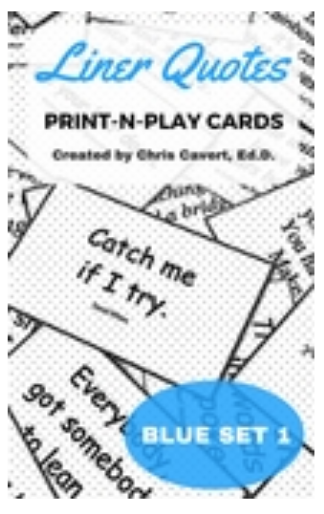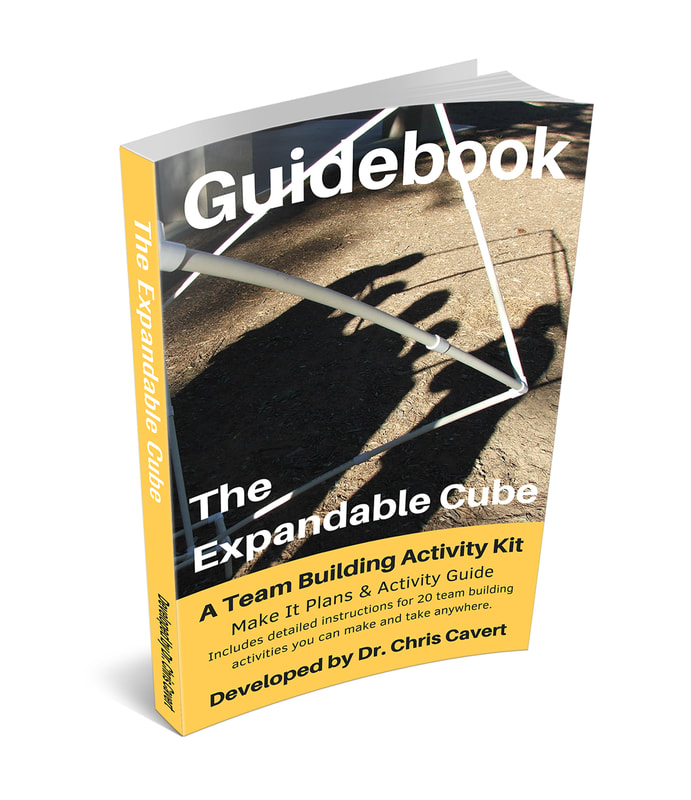I've been using Stepping Stones (introduced to me as Magic Stones) since I learned it during my first Project Adventure workshop in the early 90s. Diving into my library, the earliest write-up I could find is in Karl Rohnke's, The Bottomless Bag (1991). (FYI: This book is a compilation of activities Karl shared through, The Bottomless Bag (paper) Newsletter he wrote, 'mimeographed' and sent out to his 'mailing list' - like, through the mail USPS style - during the 70s and 80s. So, I'm guessing Stepping Stones began before the 90s at some point?)
In, The Bottomless Bag, there is less than a half-page description:
Divide your group into smaller groups of five. Each group is given 4 rubber (plastic) gym spots [these basic 'poly' spots, we call them now, are about 10 inches in diameter]. Ask all the groups to physically cross the width of a basketball court as quickly (timed) as possible.
Then there are a few Rules:
- Only the spots can be stepped on.
- No one may touch the spots with their heels - ball of the foot only.
- If someone inadvertently touches the floor, he/she must return to the start, and anyone touching them must also return.
This was the first introduction to Stepping Stones (that I know of). Things required and implied in the directions:
- Players are on their tippy-toes the entire time!! (Have you ever done it this way?!)
- The 'start' of the challenge is at one side of the basketball court - so, if you are not using a basketball court, set up a traveling distance with cones or ropes about the width of the court.
- If a player, or more, need to go back, the spots are left with the traveling group - they need to go back with spots and pick up the ones who went back. The challenge is for "all the groups to cross."
- The directions never said the smaller groups could not help each other.
- Since it's being timed, another round could be presented in order to better the time.
The next write-up I found (now, 1.5 pages long) is by Steve Butler in the book, Quicksilver (by Steve and Karl Rohnke), published in 1995. First Steve says, "This seemingly simple activity is fast becoming one of my favorites." So, he picked up the first description and added his ideas.
First he suggests some alternative props that can be used:
- Rug Pads - 12-inch square 'samples', we used to call them (if you could score the samples with the sewn edges you were golden!). Or, odd-shaped rug pieces big enough for 2-4 feet.
- 18-inch long, 4-inch x 4-inch pieces of lumber. [These are challenging!!]
- Rubber spots - as required in Version 1.0
Steve changes up the activity to one group and "before time runs out." In his words, "People are assembled at Point A, given one prop less than their number (e.g., nine people get eight props) and told to arrive safely with the entire group at Point B before time runs out." He then goes into a fantastical story about traveling through space to another planet and the props are their "life-support vehicles," and any vehicle can support as many people as can stand on it.
His Rules:
- Anyone touching the ground in space (between points A & B), must return to the home planet for decontamination and spiritual healing. All travelers are expected to arrive safely at the new planet. [No more tippy-toes required, but might be needed.]
- For a life-support vehicle to function, someone must be touching it at all times. If a life-support vehicle is untouched for even an instant, it ceases to function and it is immediately removed from the activity.
- Advanced Rule: Life-support vehicles only move in a forward direction. [This implies, if someone touches the ground in space, the challenge will have to be re-started.] Steve uses this rule to "prohibit the solution of having people 'shuffle" across space using two props as skates then sending them back for someone else to use."
About the boundaries: Steve shares, "It makes sense to set the boundaries far enough apart so that the group will need to recycle some of their props in order to cross the gap."
About time: There is no reference to how much time is given in Steve's directions. I like the idea of beating a set time. In my (Chris) thinking, I would provide a long window to start. Then, ask the group to set a goal for traveling back (to their home planet). A nice activity when working on goals and goal setting.
Variation from Steve:
- Divide the group in half. Each group starts from a different side of the A to B crossing. (Or, Steve says, "each group starts at a different planet.") The groups are challenged to exchange places. Each group gets one less prop than people. We don't say this, but the groups can share props. "The focus of the problem suddenly becomes one of identifying whether two different goals can be pursued simultaneously for a common good, or will the two groups operate independently and/or competitively."
As far as I know, I thought of this version during a program planning session - I have several sets of Teamplay Tubes to use for hurdles. (And, this does not mean I'm the first one to use this idea - their are TONs of creative souls out their thinking up the same stuff!! Someone could have been doing this years before me.) If you don't have PVC tubes and fittings for the hurdles, use any sort of prop to step over and then set up something to go through/under (e.g., Hula-Hoops) - creativity is on your side.
It's the same challenge - get from point A to B. Everyone going one way, or start at both sides.
Props: Any of the props suggested above can work, my new favorite:
- 12-inche long by 2-inch by 6-inch boards (seen in the pictures)
Rules: All the rules above can apply. Here are my additions:
- If someone touches the ground, this person goes back to the start and brings a board with him/her.
- If someone touches one of the obstacles, this person goes back to the start and brings a board with him/her.
- Everyone is required to go over the low obstacle and through/under the high obstacle.
I like this version because it adds a little more suspense to the journey.
Have FUN out their my friends!
Chris Cavert, Ed.D.








 RSS Feed
RSS Feed